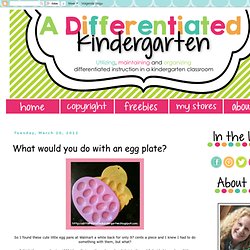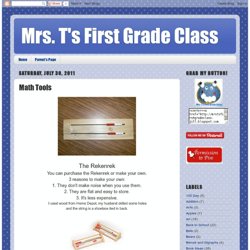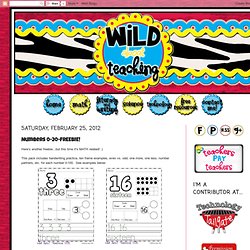

Shari Sloane - Educational Consultant. Math Centers and Games (Click on any image to see a larger version of that image.) 10s Go Fish - This game is played just like "Go Fish.

" Instead of asking for a card to match your card, you have to ask for a card that would add with one of your cards to make a sum of 10. I introduced the game with out class 4th Grade buddies, but it was still really difficult. So I made up this little cheat sheet to show that combos that make 10. Click here for the 10s Go Fish Cheat Sheet. Shape Fill In - This is the perfect game to differentiate your instruction. Click here for the Shape Fill-in Star. Click here for the Shape Fill-in Heart. Shake and Share - To play this game, you need to make Casino bottles.
Click here for the Shake and Share Addition PDF. Kindergarten. Oh, how I love easy games that are engaging for the kiddos and require low prep time! Especially when those games develop critical skills, like composing and decomposing numbers and making combinations for ten. Students who know their combinations for ten (ex., 3 + 7, 2 + 8, etc.), and understand how numbers can be decomposed, have powerful tools for developing fact fluency. For example, a student who knows that 5 can be decomposed into 2 and 3 can use that knowledge to master a more difficult fact, like 8 + 5, by making a 10 and then adding 3 more.
Along the same lines, a student can extend the knowledge that 7 and 3 makes 10 to multi-digit numbers, and decompose 25 to grab a 3 and make a friendly number out of 37. So, tonight I have two versions of the same game. Grab both versions of the game here. What would you do with an egg plate? So I found these cute little egg pans at Walmart a while back for only 97 cents a piece and I knew I had to do something with them, but what?

I think there are about a 1000 ideas that ran through my head, but in the end I decided to make a little differentiated math activity for my upcoming change in math stations. I know that one of the strategies for differentiating is using different kinds of materials so I'm always looking for new and interesting ways to use items I find. Probably just like everyone else out there. Little Minds at Work. Math Tools. The Rekenrek You can purchase the Rekenrek or make your own. 3 reasons to make your own: 1.

They don't make noise when you use them. Numbers 0-20-FREEBIE! Here's another freebie...but this time it's MATH related!

:) This pack includes handwriting practice, ten frame examples, even vs. odd, one more, one less, number partners, etc. for each number 0-100. See examples below: Measurement. Pages Kindergarten Permission To Pin Follow by Email Grab my Button Followers Blog Archive.

Learning About 2 D Shapes. We made a tree map describing the different shapes Recording Shapes from our classroom We read some shapes book!

We used Tana Hoban's book for a search of shapes in our school These two Voice Threads connect to our shape investigation. Students can make comments on the pictures from home. Kindergarten math centers. Using Guided Math to Strengthen Students' Math Learning, Grades K-2. The Math Learning Center Catalog. Common Core State Standards for Mathematics. Triangularcards. PreK Numbers, Shapes, Colors Review. To review all of the numbers, colors and shapes we learned as we went through our Letter of the Week curriculum, I made some fun review games!

Drnicki7. Math Playground - Online Math Games that Give your Brain a Workout. Fun math for kids. Math Learning Center. Dr. Nicki's Guided Math Blog. Illustrated Standards Count to 100 by ones and by tens.

(see illustrations) Count forward beginning from a given number within the known sequence (instead of having to begin at 1). (see illustrations) Write numbers from 0 to 20. Understand the relationship between numbers and quantities; connect counting to cardinality. When counting objects, say the number names in the standard order, pairing each object with one and only one number name and each number name with one and only one object. Understand that the last number name said tells the number of objects counted. Understand that each successive number name refers to a quantity that is one larger. Count to answer “how many?” Identify whether the number of objects in one group is greater than, less than, or equal to the number of objects in another group, e.g., by using matching and counting strategies. Compare two numbers between 1 and 10 presented as written numerals.
Fluently add and subtract within 5. Recognize area as additive. Measurement Worksheets and Printables. Addition & Subtraction Games. Students place markers on the numbers 2-12.

Students toss two 6-sided dice, find the sum and remove a marker from that number, if there is still one. The first player to remove all markers wins the game. This game can be used as addition practice or as an introduction to the probability of the different outcomes of rolling two dice. This game was developed by a Monmouth University student for the Probability Fair. Download the Face Off!